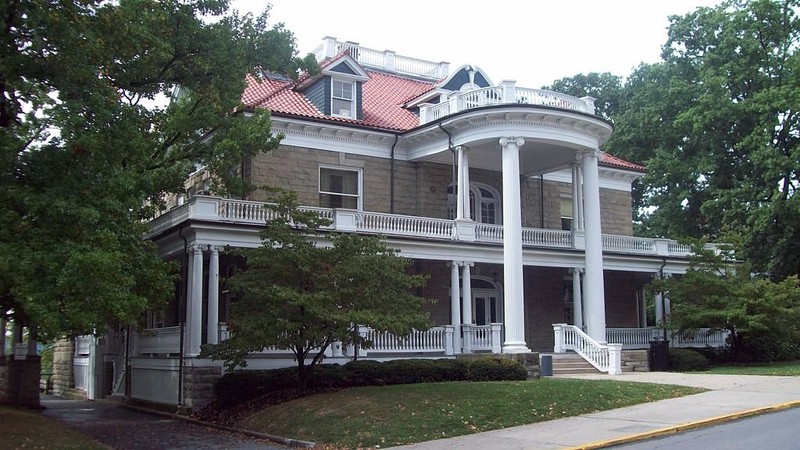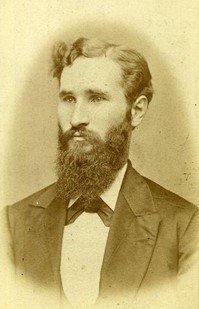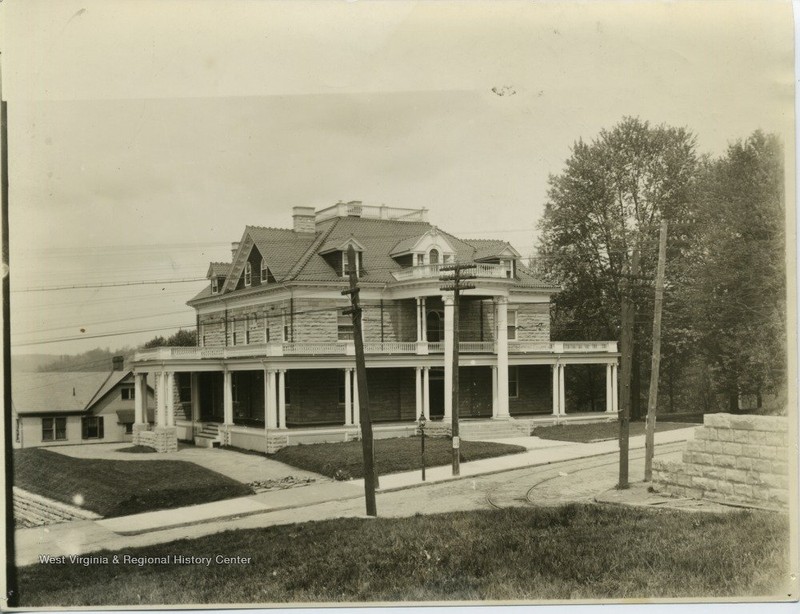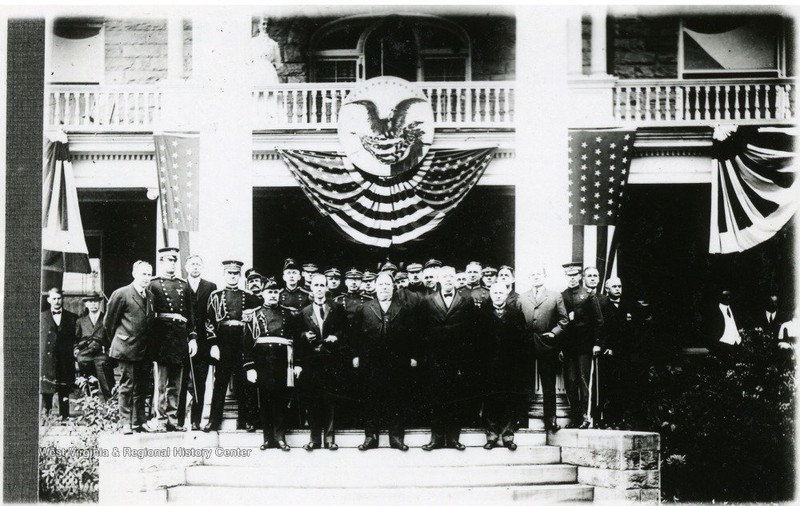Purinton House
Introduction
Text-to-speech Audio
Images
Purinton House, now home to WVU's International Students & Scholars Services. Courtesy of Wikipedia.

Daniel Boardman Purinton, WVU president and namesake of Purinton House. Courtesy of The West Virginia Encyclopedia.

Purinton House in 1906, shortly after its construction. Courtesy of the West Virginia & Regional History Center.

William Howard Taft at WVU President Thomas Edward Hodges' inauguration in 1911. Courtesy of the West Virginia & Regional History Center.

Backstory and Context
Text-to-speech Audio
When he became the President of West Virginia University in 1901, Daniel Boardman Purinton pursued an aggressive policy of university expansion that included (most notably) the school’s first library in Stewart Hall and Purinton House itself. Purinton purchased the land upon which Purinton House stands from noted geologist Israel Charles White, a WVU faculty member at the time. The most notable event to take place at Purinton House by far was U.S. President William Howard Taft’s delivery there in 1911 of his “World Wide Speech” in defense of his administration’s foreign affairs policies. After the president’s residence moved in 1967, Purinton House became the headquarters of the school’s Alumni Association. It currently houses the university’s International Students & Scholars Services program.
The original owner of the land upon which Purinton House stands, Dr. Israel Charles White, is a prominent figure in the history of the geological sciences, particularly for his role in the widespread acceptance and use of anticlinal theory in industrial mining. As one of the six students that formed the first class at the Agricultural College of West Virginia in 1867 (what became WVU) White was one of the university’s oldest alumna and continued to play an active role in the school’s growth both as a faculty member and investor after his graduation. In addition to the land where Purinton House is now located, White’s property holdings included the locations where the main library, mineral industries building, stadium, and hospital now stand. White also served as the treasurer of the building committee for Mountaineer Field and invested heavily in the development of the South Park neighborhood to the south of downtown Morgantown. He is most remembered, however, for his use of anticlinal theory to aid mining companies searching for oil and gas. This theory (which posited that oil and gas deposits collected in permeable bedrock at higher elevations) soon became the industry standard, propelling White to the forefront of his field. As a result, White became West Virginia’s first state geologist in 1897 and continued to serve in that capacity in addition to his responsibilities at WVU until his death in 1929.
It was during this period that White sold the land where Purinton House stands to President Purinton, who hired Uniontown architect John Charles Fulton to design the presidential residence in 1904. Fulton, who also played a role in the design of the Monongalia County Courthouse in 1890 and Brick Row (now 123 Pleasant Street) the following year, designed Purinton House as an eclectic mix of Colonial Revival and Neo-Classical features. The balustraded roof over the porch and widow’s walk, for example, are particularly representative of the Colonial Revival style, while the building’s prominent Ionic columns at the front are typical of Neo-Classical design.
Critics of Purinton’s expansion program lambasted the president for accepting what they considered an extortionate sale price for the land upon which Purinton House was built and for his decision to use his own money to begin construction on the structure when he failed to receive approval for the use of public funds. By the time Purinton left his position as head of the university in 1911, however, the controversies surrounding the building had largely faded and his successor Thomas Edward Hodges’ inauguration ceremonies took place in part on its front porch in 1911. President William Howard Taft was present for the ceremony, and even spoke to those in attendance. His address, named the "World Wide Speech" for Taft’s assertion that his administration’s foreign policy agenda could bring about worldwide peace, served largely as a defense of what has since become known as “dollar diplomacy.” Taft, unlike his predecessor Theodore Roosevelt, preferred the use of arbitration and financial incentives in foreign affairs as opposed to armed force. While Roosevelt (who Taft served as Vice President) chose to send U.S. troops to both the Dominican Republic and Panama during his tenure in the White House, Taft attempted in contrast to influence events in other countries by funneling U.S. arms and wealth to American allies across the globe. His efforts were generally unsuccessful, serving to encourage anti-American sentiment among the citizens of countries like Nicaragua, where Taft supported a conservative rebellion against the government there after it defaulted on its loans.
Taft’s foreign policies eventually made him a target for criticism even within his own party, hence his fervent defense of those policies in his 1911 speech at WVU. Such speeches evidently did little good. When the 1912 election season began Roosevelt himself chose to challenge Taft in the primaries, alleging that Taft had abandoned his party’s ideals in both foreign and domestic terms. His assertions apparently held weight, and by the time the Republican National Convention took place in early 1912 Roosevelt held a vast majority of the delegates (278 of the 362 chosen by election). Despite this fact, Taft was able to manipulate the party machinery behind the scenes and ultimately secured the nomination. His actions so angered Roosevelt, however, that the former president went on to run on a third-party ticket, splitting the Republican vote and handing the election to Woodrow Wilson.
Purinton House’s connections to figures like White, Purinton, and Taft make it a unique window into the history of the geological sciences, U.S. foreign policy, and West Virginia University itself. Those connections are indicative of the university and surrounding community’s deep ties to a much broader past that encompasses not only Morgantown, but the state of West Virginia, the nation, and the world at large as well. It is also representative of the unique blend of architectural styles that came to define the area during the period of local expansion and revival that took place at the turn of the twentieth century in Morgantown itself. While the presidential residence moved to a new location in 1967, that history remains on display in the lines designed by John Charles Fulton over a century ago.
Sources
The Inauguration of Thomas Edward Hodges, as President of West Virginia University. Morgantown, West Virginia, November 3, 1911. Morgantown: West Virginia University, 1911.
